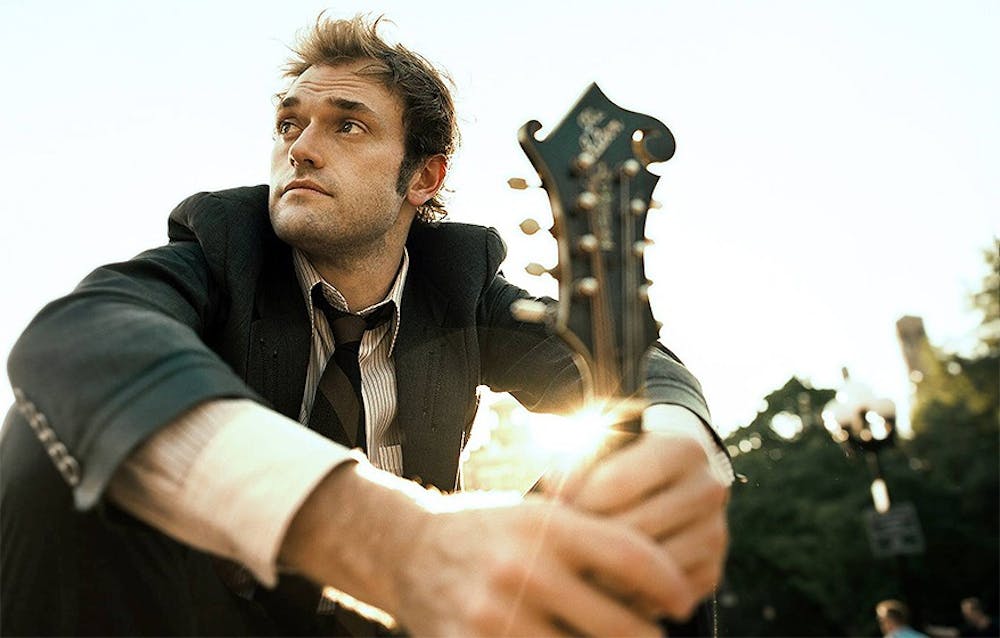CT: Yeah, or just that they have different strengths. Different strengths and weaknesses, and the music is pretty comprehensive in its scope. So it’s going to tackle the strengths and weaknesses of the instrument. Bach’s music for the violin, it’s not totally idiomatic to the violin, and it’s not totally idiomatic to the mandolin. So I do think that it’s not such a leap of faith to play them on the mandolin instead of the violin. I do think that if you set the music in front of someone who knew music very well but didn’t know the pieces at all, that if it’s written for the violin or the mandolin, they’d be hard pressed to pick one. I think they’d be just as likely to pick the mandolin as the violin.
I should also point out that there’s no transcription necessary. It saddens me when people say I play transcriptions of the solo violin music, because nothing needs to be changed to play it on the mandolin. It’s built for that.
DTH: You’ve been doing a lot of press with this project, has there been any aspect of it that you’ve wanted to talk about but haven’t had the right opportunity?
CT: One thing that’s really important to me is I delight in musical contrast. And that’s something that really directs my listening and my creative activity and my performance activity. But one thing I keep learning during all of that — listening, playing and writing — is that there’s nowhere near as much fundamental divide between these aesthetically different disciplines as people seem to think that there is.
It could seem like this huge departure for me to make a Bach record after stuff like the last Punch Brothers record or something like that, but it doesn’t feel that different to me. Certainly, when you’re dealing with Bach, you’re dealing with the life of the greatest musician of all time, and I think a lot of various musicians agree he’s the greatest musician of all time. So there’s that. But as far as the actual — the nuts and bolts of music making don’t really change. I still want it to be rhythmically compelling, and I want it to engage the mind, the body, the soul, the heart. And that doesn’t change.
That doesn’t change at all, my approach to doing this to playing a fiddle tune, writing a song or a longer piece of some kind. It’s kind of all the same, it’s like different pieces of the same pie. I think that too often the story is like, “Whoa, look at the left turn that this kid just took!” Where to me, it’s like, the scenery changes, but I’m not making something bizarre.
DTH: I’ve noticed that in a lot of writing, I feel like I see “genre-hopping” or that kind of thing a lot.
CT: Oh, that drives me crazy. “Genre hopping,” oh my God. That stuff makes me want to die. It was a very nice piece that they (The Wall Street Journal) wrote. I was thrilled that they took the time, and I thought it was a nice piece, but it was like, God damn, genre hopping is a miserable term.
For one, there’s nothing to hop. Again, I’m going to say that word, aesthetic convention. Genres are visual descriptor, not an aural descriptor. Like, when someone mentions a genre name, it’s not very helpful describing the sound of something.
It’s far more helpful describing the look of it. It’s like, you say bluegrass, and you can probably get a picture in your mind — banjo, mandolin, fiddle, guitar, bass, maybe a dobro. But as far as what it actually sounds like, some people are going to say, like, ‘Oh yes, part of the tradition started by Bill Monroe, carried out by Flatt and Scruggs and The Stanley Brothers, Sam Bush, David Grisman, Edgar Meyer, Bela Fleck, Mark O’Connor, people like that.’ And then you say bluegrass, and some people are going to think of the old TV show Hee-Haw. It’s drastically different things.
And if you say rock, some people are going to think ‘Oh, Linkin Park, Nickelback,’ and then some people are going to think, ‘The Beach Boys, The Beatles and Radiohead.’ It’s not helpful. Those words aren’t helpful at all, it’s visual descriptors. Mentioning individual artists is more helpful, so we can be very, very clear. So it’s like, you’ve heard this, or you haven’t heard it. I like to think of music in terms of there are two genres, and those genres are good and bad. You’re really trying to make music that falls into the former genre.
DTH: You’re calling this tour Bachtoberfest, but what are some other good Bach puns you’ve been able to work out of this?
To get the day's news and headlines in your inbox each morning, sign up for our email newsletters.
CT: I have come up with so many Bach puns — well, me and my friends. I think my favorite so far is Bachamole, a tasty snack. I did a little contest on Twitter and had people come up with Bach puns that we should have called the record, and the best one was Thile Wonka and the Bacholate factory. That was the best one. My hat is off. Whoever came up with that, they have my full respect.



